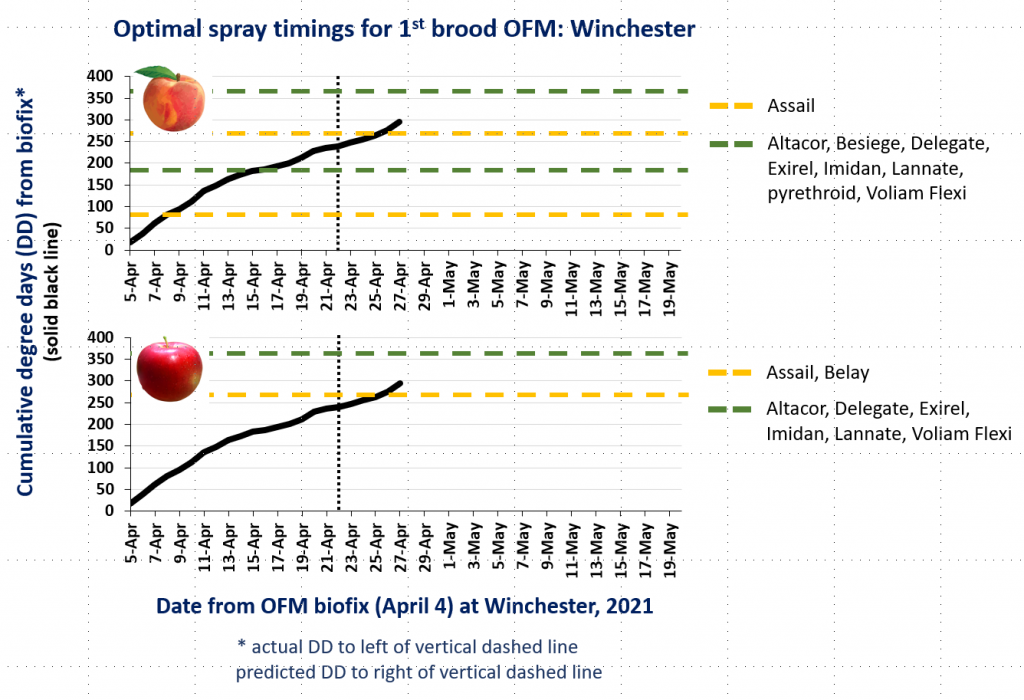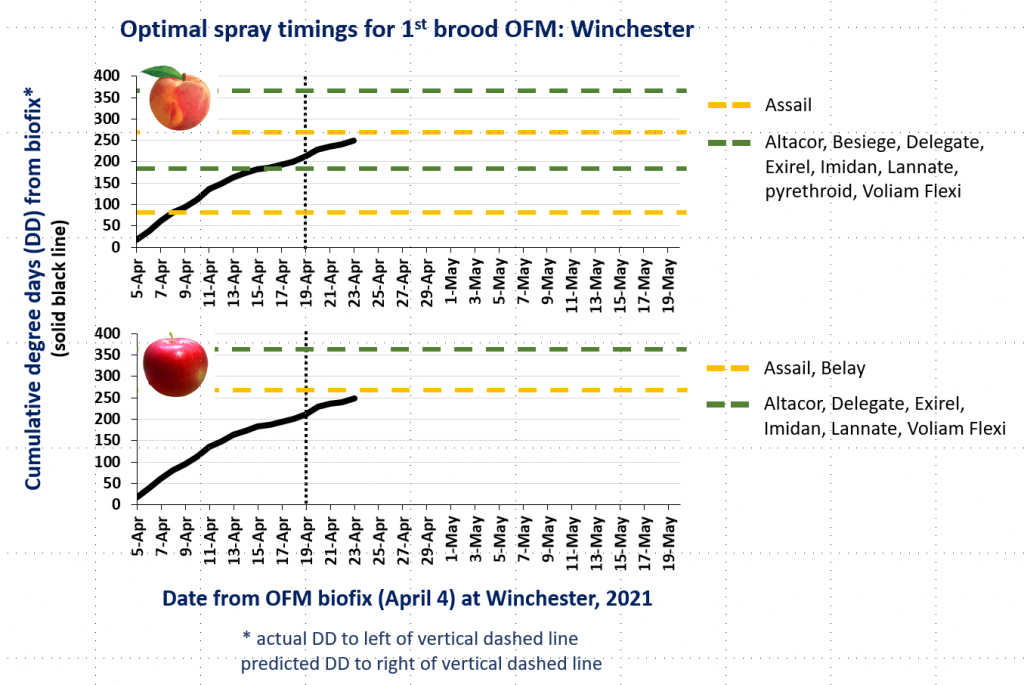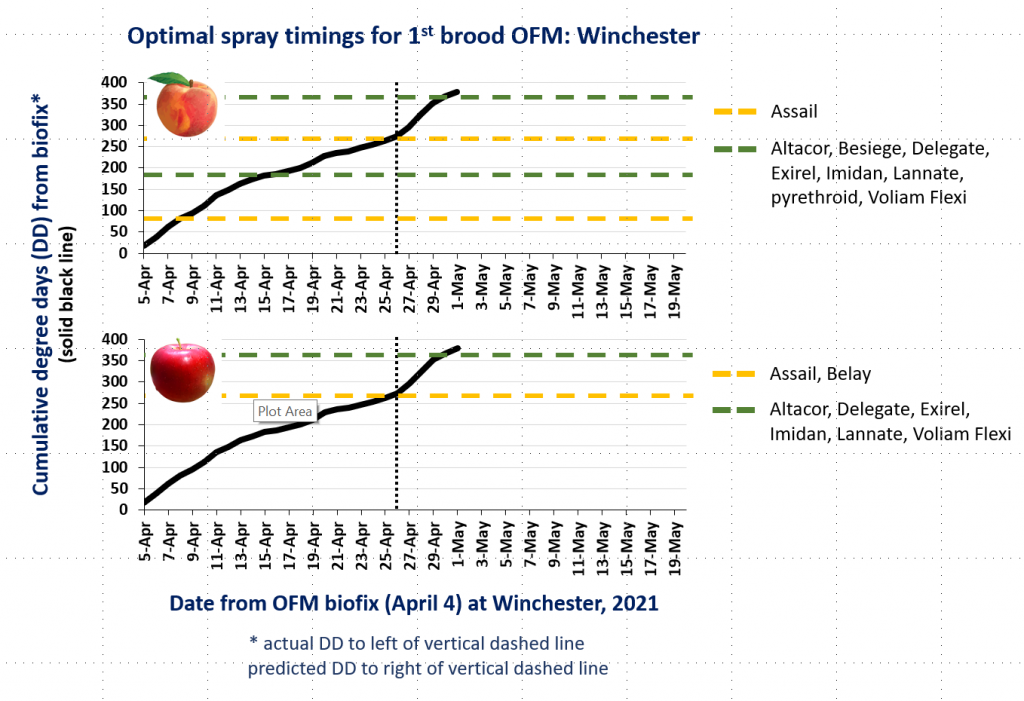
Author Archives: Chris Bergh
OFM Degree Days and Optimal Spray Timing, 4.22.21
OFM Degree Days and Optimal Spray Timing
OFM Degree Days and Optimal Spray Timing, 4.15.21
OFM degree-days from biofix and optimal spray timing
Last year I tried a new approach to reporting degree-day (DD) accumulations from biofix for OFM and CM, and optimal insecticide timings based on reaching critical DD accumulations related to the percentage egg hatch for each generation of the target pest. This approach received favorable feedback, and I’m going to use it again this year by posting updates on Mondays and Thursdays, which you should receive on Tuesdays and Fridays. The graphs below provide this information for OFM management in peaches and apples (CM biofix not yet established for 2021). Note that the solid black line shows daily DD accumulations from OFM biofix (April 4), the colored dashed lines are optimal timings for different insecticides, and the black vertical dashed line indicates actual DD (to its left) and predicted DD (to its right), based on forecasted temperatures. All of this information is taken from Cornell University’s NEWA forecasting site at http://www.newa.cornell.edu/. When the solid black line crosses a dashed colored line, read down to the x-axis from the point of intersection to find the date of recommended timing for specific products.
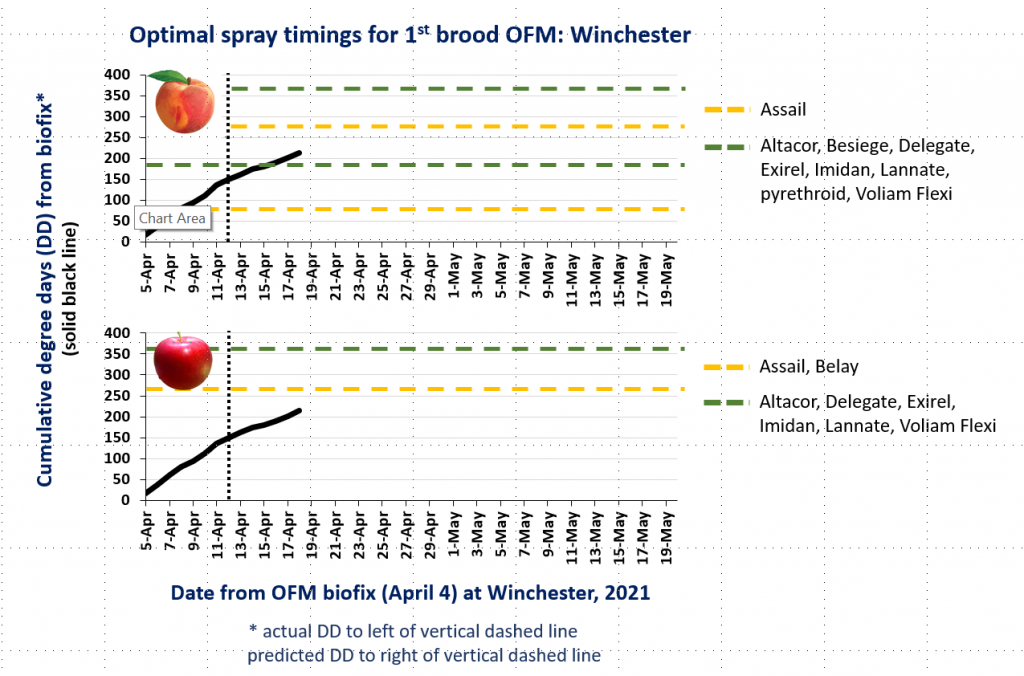
Oriental Fruit Moth Biofix at Winchester
We have had sustained and fairly decent captures of oriental fruit moth (OFM) at the Winchester AREC over the last two nights, and anticipate additional captures this evening. Consequently, I am calling OFM biofix in this area for April 4. Application of OFM sprayable pheromone now would be a strong option against the first generation of this pest by disrupting mating and the deposition of fertile eggs, thereby reducing the size of its population going forward. One application at the full rate may provide control for the duration of the first flight, although heavy or prolonged rain may necessitate a second application. Alternatively, the low rate of sprayable pheromone can be applied at 7-10 day intervals during the first flight. There are also a number of hand applied pheromone dispensers for mating disruption, with application rates per acre and duration of protection varying among products, as indicated on the label for each.
Japanese maple scale reported on Virginia apple trees
During pruning this winter, there have been some reports of Japanese maple scale on apple trees. I have posted a photo of once such instance below, submitted in January by Extension agent, Tim Ohlwiler. Japanese scale has a broad host range and two generations per year in our area, and overwinters as immature 2nd instars. As with other scales, its management begins with an application of dormant oil (2-3%) prior to bud break in the spring, when temperatures are above about 55 F for 4 to 5 days. First generation crawlers should be targeted between mid-May and early June using 2% horticultural oil alone or at 0.5 – 1% in combination with Esteem or Centaur. Second generation crawlers should be targeted in early August, using the same products as for 1st generation. Researchers at the University of Maryland published a very informative fact sheet about Japanese scale biology and management that can be found at the following link.

Brown marmorated stink bug update
Researchers from around our region are reporting much higher captures of brown marmorated stink bug (BMSB) in pheromone traps than have been recorded at this point in the season in recent years. Based on experience, we might expect BMSB numbers to increase over the next few weeks. Its feeding on tree fruits in August and September can result in substantial injury at harvest. Also, of course more adults can translate to higher numbers of BMSB invading homes and other buildings during their dispersal to overwintering sites between the latter portion of September through much of October. My post on August 11 included a table of insecticides that are considered effective against BMSB and a a reminder that scouting for BMSB injury (photos below) in apple orchards at this point might be most efficiently accomplished by examining fruit from the mid- and upper canopy of trees in border rows adjacent to woods; this is the “zone” where its injury at harvest has been most prevalent. I encourage growers to be vigilant in paying attention to this as the crop matures.
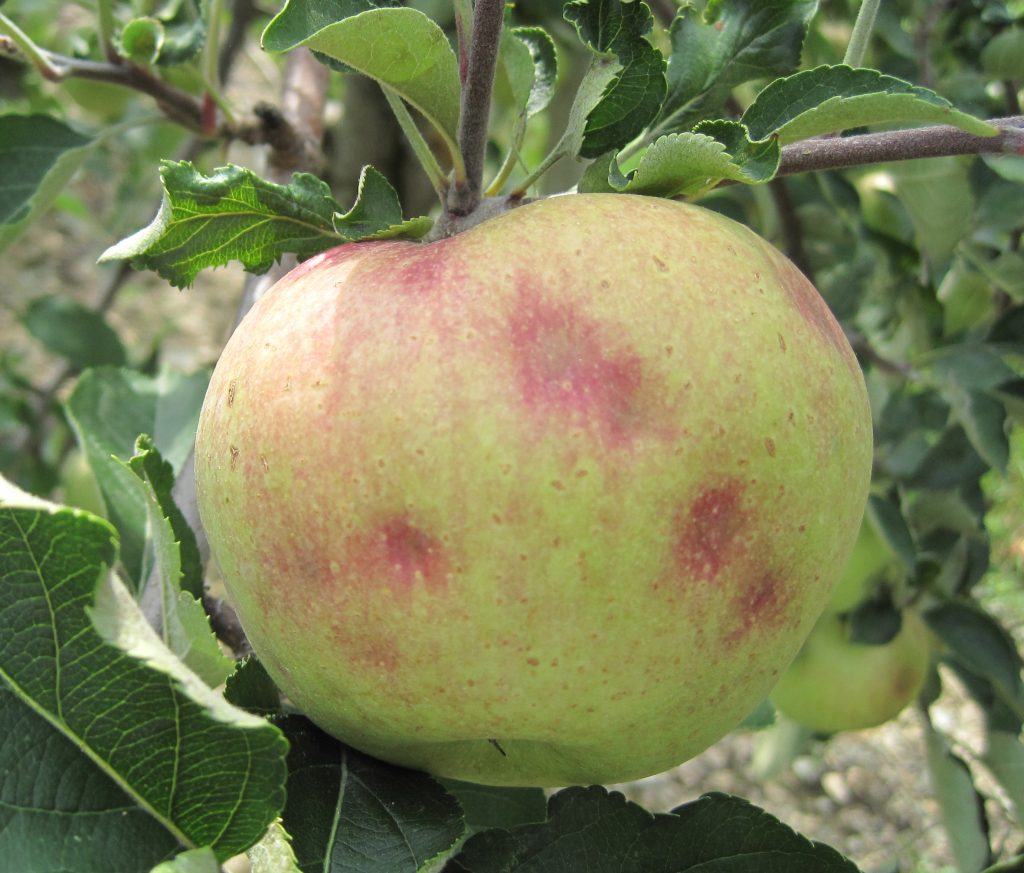
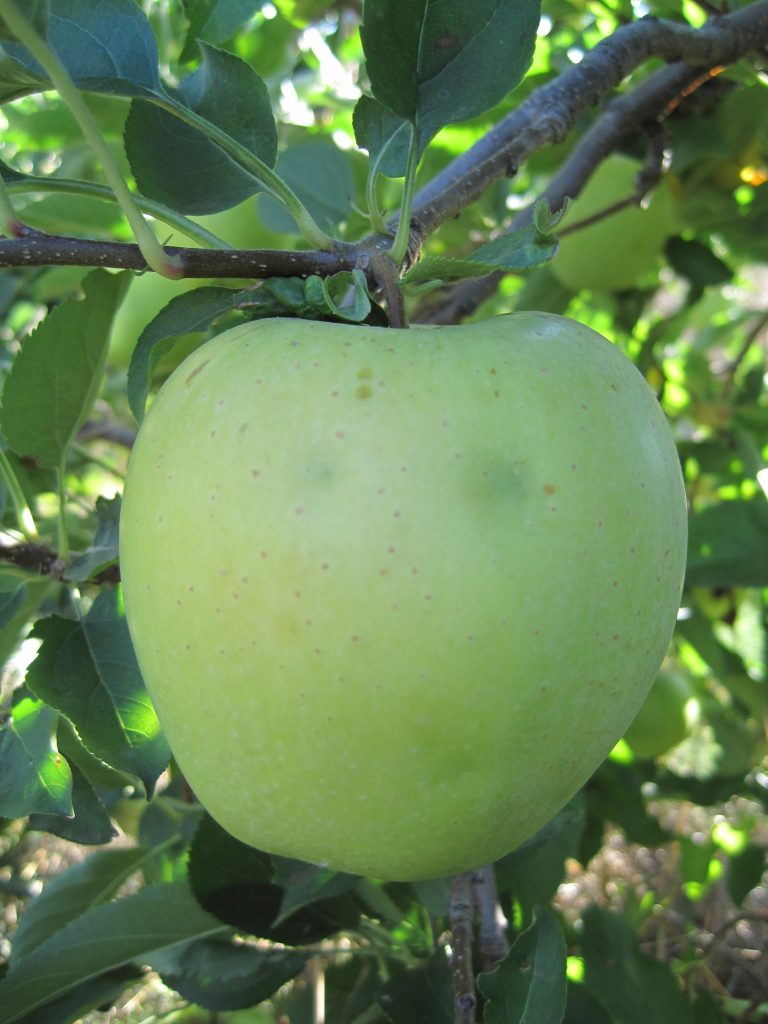
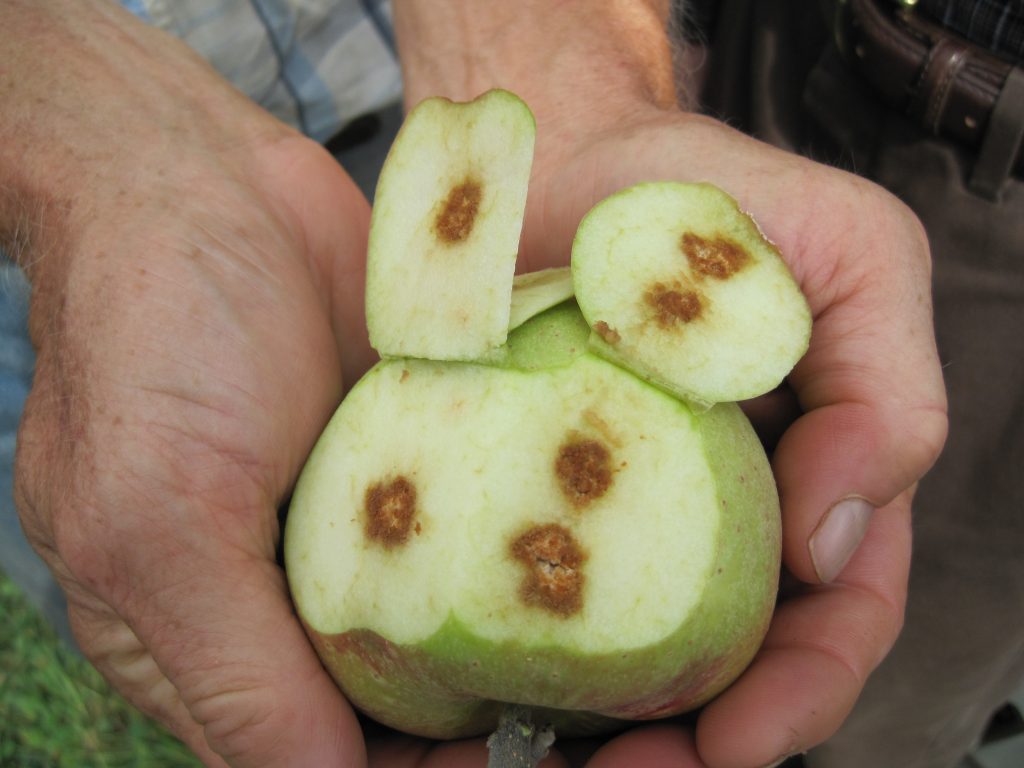
Tree Fruit Pest Management Update
Brown marmorated stink bug (BMSB) pheromone traps are showing the presence of new adults and late instar nymphs that will soon molt to the adult stage. Captures vary among sites, but at some locations are considerable for this point in the season. These adults will produce another generation of nymphs that will become the adults that invade buildings in the fall when they seek overwintering sites. Nymphs are considered more susceptible to insecticides than adults, but older nymphs (3rd and 4th instars) can cause similar injury to fruit as adults. BMSB populations (based on captures in traps) are almost always highest between late August and early October, and feeding by BMSB during this period can cause considerable fruit injury and in some cases, injury to apples that is not apparent at harvest but is expressed after a period in post-harvest cold storage. Woodlands next orchards tend to be the “riskiest” borders in terms of BMSB prevalence, and injury to apples tends to be highest in fruit at the top and middle of trees in border rows next to woods. To gain a sense of BMSB injury at this point in the season, scouting could reasonably focus on fruit from these trees and canopy locations.
BMSB management options from this point forward are summarized in the table below. Because the residual efficacy of most insecticides against BMSB is fairly short, alternate-row-middle sprays against it at 7- to 10-day intervals are considered strongest. Note that many of the products listed below are pyrethroids or contain a pyrethroid; they and Lannate can cause secondary pests to flare.

With respect to codling moth (CM) and oriental fruit moth (OFM), management of third generation CM and fourth generation OFM occurs in August. The degree-day egg hatch models are not used to guide management for the final generation of these pests. Rather, pheromone trap-based thresholds can inform decisions about whether control is needed. Average captures (e.g. across 2 or more traps) per week of more than 5 CM per trap and more than 10 OFM per trap are considered to reflect a population that should be managed.
OFM Degree Days and Optimal Spray Timing, 7.30.20
I’m having unexplained issues with updating my degree day graph for 3rd brood OFM, so today will just post by text. The optimal timing for the second half of third brood OFM larvae in APPLES is as follows: Assail at 2800 – 2900 DD; Altacor, Besiege, Delegate, Exirel, Imidan, Lannate, Verdepryn, or Voliam Flexi at 2900 – 3000 DD. In the Winchester area, we will reach 2800 DD on Aug 1-2, and 2900 DD on Aug 4-5.

